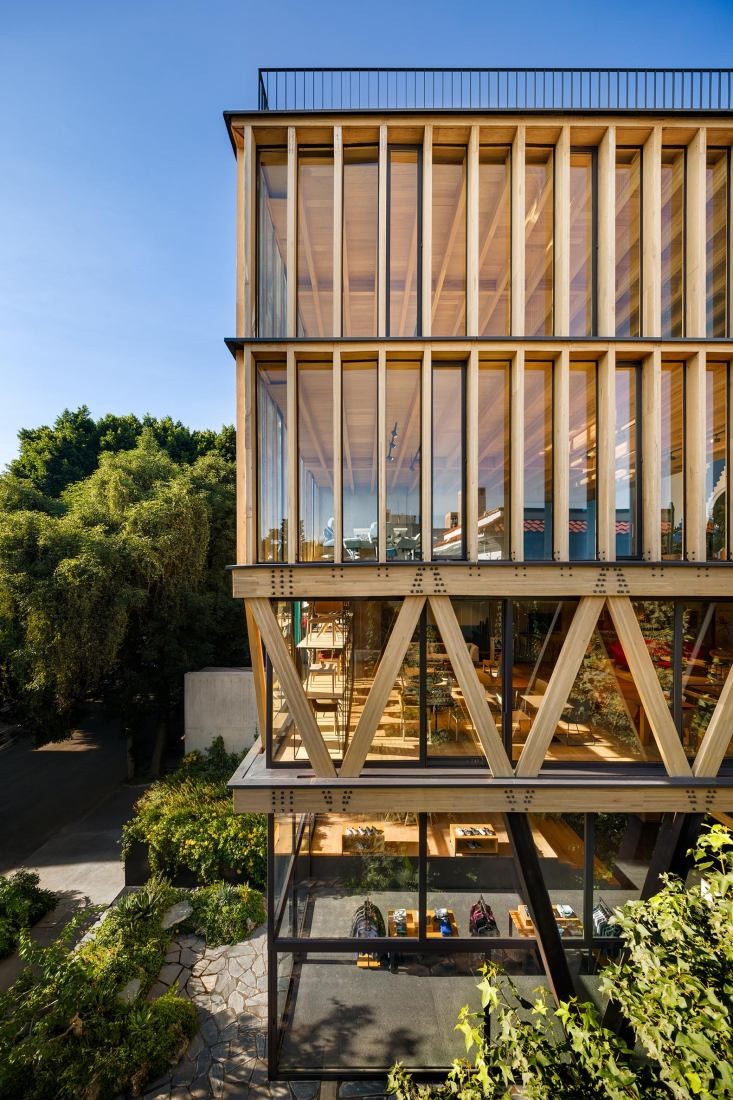Exploring El Jardín Anatole by Dellekamp / Schleich: Where Aesthetics Meets Earthquake Resilience

Design Overview
El Jardín Anatole, designed by Dellekamp / Schleich, is a slender five-story retail building, the first in Mexico with a laminated wood structure (using oak from the country's north), except a dramatic V-shaped steel truss at ground level and concrete used for the elevator and stairwells. It is a case study of cross-laminated timber (CLT) design and its seismic potential. Located on Anatole France Street in Mexico City's Colonia Polanco neighborhood, it houses a clothing store, a furniture showroom, and office space.
A double-height retail space on the ground floor is almost entirely clad in glass, with a single, dramatic steel truss flanking the entrance.
The steel frames the timber bands that wrap the second story, extending slightly beyond the ground floor with a series of wooden trusses. More glass fills in the gaps between structural timber elements.
All visible vertical wooden elements are structural and were left exposed to show off the innovative construction methods.
Also Read: 5 Times Architecture Made Big Impressions For Commercial Advertisements

Sustainability and Earthquake Resilience
El Jardín Anatole is currently Mexico's largest mass timber building (no small feat in a country of 126.2 million people). Cross-laminated timber (CLT) is popular because it has a similar strength-to-weight ratio to concrete, but it is five times lighter and has much lower carbon storage. (Scientists discovered that hybrid CLT structures can reduce global warming by an average of 26.5 percent compared to concrete construction.) At El Jardn Anatole, Dellekamp / Schleich used concrete sparingly: only the elevator cores and stairwells use the building material that energy codes are gradually phasing out.
Because Mexico City is prone to earthquakes, the studio wanted to ensure that it built a strong, flexible structure that could withstand seismic activity. A study in California discovered that high-rise timber structures can withstand 7.7 magnitude earthquakes and return to stasis within minutes, damage-free. Because of how well it performs in tension, CLT was an obvious choice for El Jardin Anatole, built on a site that sees an average of 74 earthquakes yearly.

Project Description by Dellekamp / Schleich
"El Jardín Anatole arises from a residual void in Mexico City with potential for density, where the courtyard of a house with historical value was converted into a mixed-use building.
Due to the added value of the area, few properties have areas accessible to construction, so one of the premises of the design was to blur the limits between the public and the private, creating a public space for connection with the city.
As a result of our continuous research to find alternative materials and construction systems with low impact, the use of wood as the main element for the construction of El Jardín Anatole, the first building with a wooden structure in Mexico, arose. This way, the architectural expression is based on the structural system to create a wooden box supported by a single steel "V" column that floats over a public square full of endemic vegetation.
The program responds to the condition of the place with commercial premises on the ground floor, which frees the structure to compose a continuous space with the square. Subsequently, three levels of offices are developed, governed by the modulation of structural wood to generate flexible spaces free of intermediate columns.
Using few materials, orientation, and structural efficiency allowed the creation of a building that stands out for its simplicity to become an oasis in the middle of the city."
From Digital Models to 3D-Printed Homes: Jaspreet Kaur Lall Explains How the Innovation Changes the Construction Industry

Future Belongs to Green Construction: Sampath Kumar Paspunoori Explains One of the Key Trends in the Construction Industry

Kamala Harris' Campaign Ad Uses Iconic Visuals from Carrie Mae Weems to Connect with Voters

Historic Ancient Roman Ruins in Baalbek Remain Strong After Israeli Air Strikes; Locals Seek Cultural Protection

4 Ways to Honor Departed Loved Ones in Your Home Design













